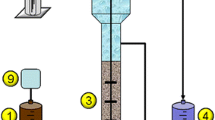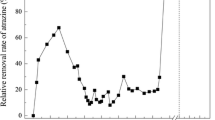Abstract
Biodegradation is an effective technique to remediate polluted soil and groundwater. In the present experimental study, a mixed microbial culture obtained from the wastewater treatment sludge of a chemical industry was used to degrade liquid phase benzene, toluene, ethyl benzene, and xylene (BTEX), at individual initial concentrations varying between 15 and 75 mg/l. Experiments were conducted according to 2k−1 fractional factorial design at the low (15 mg/l) and high (75 mg/l) levels of BTEX concentrations, to identify the main and interaction effects of parameters and their influence on biodegradation of individual BTEX compounds in mixtures. The individual removals varied between 16% and 75% when the concentrations of B, T, E, and X were sufficiently low in the mixture. However, both synergistic (removal of ethyl benzene) and antagonistic (removal of benzene) behavior were noticed when the concentrations of toluene and xylene was increased to higher levels. The individual removals were greater than 67% at their center point levels. The total BTEX removal values were later statistically analyzed and based on the Fischer’s variance ratio (F) and Probability values (P) it was observed that the main effects for total BTEX removal were significant than the squared and interaction effects.




Similar content being viewed by others
References
Alvarez PJJ, Vogel TM (1991) Substrate interactions of benzene, toluene and para-xylene during microbial degradation by pure cultures and mixed culture aquifer slurries. Appl Environ Microbiol 57:2981–2985
Arvin E, Jensen BK, Gundersen AT (1989) Substrate interactions during aerobic biodegradation of benzene. Appl Environ Microbiol 55:3221–3225
Bartels I, Knackmuss H-J, Reineke W (1984) Suicide inactivation of catechol 2,3-dioxygenase from Pseudomonas putida MT-2 by 3-halocatechols. Appl Environ Microbiol 47:500–505
Bielefeldt AR, Stensel HD (1999) Evaluation of biodegradation kinetic testing methods and long term viability in biokinetics for BTEX metabolism. Water Res 33:733–740
Box GE, Hunter WG, Hunter JS (1978) Statistics for Experimenters. John Wiley & Sons Inc., New York
Duggleby CJ, Williams PA (1986) Purification and some properties of the 2-hydroxy-6-oxohepta-2, 4-dienoate hydrolase (2-hydroxymuconic semialdehyde hydrolase) encoded by the TOL plasmid pWW0 from Pseudomonas putida MT-2. J Gen Microbiol 132:717–726
Fritsche W, Hofrichter M (1999) Aerobic degradation by microorganisms. In: Rehm H-J, Reed G (eds) Biotechnology. Environmental Processes, Vol. 11b, Wiley-VCH, Weinheim, New York, pp 145–167
Gersberg RM, Korth KG, Rice LE, Randall JD, Bogardt AH, Dawsey WJ, Hemmingsen BB (1995) Chemical and microbial evaluation of in-situ bioremediation of hydrocarbons in anoxic groundwater enriched with nutrients and nitrate. World J Microbiol Biotechnol 11:549–558
Gusmão VR, Martins TH, Chinalia FA, Sakamoto IK, Thieman OH, Varesche MBA (2006) BTEX and ethanol removal in horizontal-flow anaerobic immobilized biomass reactor under denitrifying condition. Process Biochem 41:1391–1400
Haigler BE, Pettigrew CA, Spain JC (1992) Biodegradation of mixtures of substituted benzenes by Pseudomonas sp. Strain JS 150. Appl Environ Microbiol 58:2237–2244
Khuri AI, Cornell JA (1987) Response Surfaces: Design and Analysis. Marcel Dekker, New York
Mackay D, Shiu WY (1981) A critical review of Henry’s law constants for chemicals of environmental interest. J Phys Chem Reference Data 10:1175–1199
Martin MA, Keuning S, Janssen DB (eds) (1998) Handbook on Biodegradation and Biological Treatment of Hazardous Organic Compounds, 2nd edn. Academic Press, Dordrecht
Montgomery DC (ed) (1991) Design and Analysis of Experiments, 3rd edn. Wiley, New York
Murata M, Tsujikawa M, Kawanishi S (1999) Oxidative DNA damage by minor metabolites of toluene may lead to carcinogenesis and reproductive dysfunction. Biochem Biophys Res Commun 261:478–483
Oh Y-Z, Shareefdeen Z, Baltzis BC, Bartha R (1994) Interactions between benzene, toluene and p-xylene during their biodegradation. Biotechnol Bioeng 44:533–538
Prenafeta-Boldú FX, Vervoort J, Grotenhuis JTC, van Groenestijn WJ (2002) Substrate interactions during the biodegradation of benzene, toluene, ethylbenzene, and xylene (BTEX) hydrocarbons by the fungus Cladophialophora sp. Strain T1. Appl Environ Microbiol 68:2660–2665
Schwarzenbach RP, Gschwend PM, Imboden DM (1993) Environmental Organic Chemistry. Wiley, Newyork
Yeom SH, Yoo YJ (1999) Removal of benzene in a hybrid bioreactor. Process Biochem 34:281–288
Acknowledgement
This work was supported by the research funds for the fiscal year 2006 from the University of Ulsan in South Korea.
Author information
Authors and Affiliations
Corresponding author
Rights and permissions
About this article
Cite this article
Jo, MS., Rene, E.R., Kim, SH. et al. Removal of BTEX compounds by industrial sludge microbes in batch systems: statistical analysis of main and interaction effects. World J Microbiol Biotechnol 24, 73–78 (2008). https://doi.org/10.1007/s11274-007-9441-4
Received:
Accepted:
Published:
Issue Date:
DOI: https://doi.org/10.1007/s11274-007-9441-4




